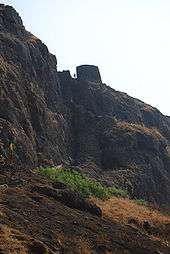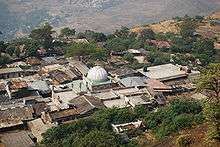Malanggad

Malanggad (also called Baba Malang) is a hill fort located in Raigad District, Maharashtra. It has an elevation of 789 m above sea level.[1]
Major features

Malangad is built on three levels. The lowest level is a plateau which is 1000 feet broad and 2500 feet long on which stands the Dargah of a Sufi saint - Haji Malang. At the other end of the plateau is the Panchi Pir which lies almost at the edge of the rock and is named after the five pirs who accompanied Haji Malang.[2] This plateaus is called Pir Machi.
The next higher level is called the Sone Machi as it is the lower part of the fort. This is a projection of rock with is 70 feet broad and 100 feet long. It is shaped like an elephant trunk.[2] It has a parapet wall with bastions on two sides but there are no machicolations to fire at an invading army.
The highest level is the Citadel which is 200 yards long and 70 yards broad. This is the summit of the hill and has no fortifications. The water supply is from five cisterns at the top of the hill with a copper pipe to carry water to the lower levels.
Haji Malang is different from other forts in Maharashtra. Whereas other forts have several gates and multiple watchtowers, art of the main gate itself. With a wall with no machicolations to fire at the enemy and no fortifications, Haji Malang is one of the few forts to depend completely on natural aspects of the hill to defend itself.[2]
History
Malanggad was built by King Naladev of Maurya Dynasty in seventh century. The fort was home to one Nathpanthi Saint named Machhindranath during this period. The fort was captured by Marathas in 17th century and later it was captured by British. Ketakars were the Killedars of the fort. Today also Ketakar family holds various rights to the place. Nearby Kalyan East 15 km, the reinforcements arrived in early October as Colonel Hartley and Captain Jameson and their troops advanced on Malanggad and finally defeated the Marathas.[2][3][3]


Current usage
[3] In 2007, Govt. of Maharashtra awarded a contract to Supreme-Suyog-Yashita consortium to build a Funicular Railway to Malanggad plateau from Malangwadi, towards Kalyan. The permissions from Forest Department took 4 years to come and the work has now started. The Malanggad Funicular Railway will be more than 1 km in length and will gain 320 M in height. It will be able to carry 1000 passengers up and down the hill every one hour.
On the eastern side of this mountain, trekking is good. It requires 1 hour to reach Pir machi from the base village, and further half an hour to reach Sone Machi. however the climb to the balekilla is very tough and risky. Only expert climbers with proper equipments and ropes should dare to climb the balekilla. There are too many shacks on the way to Pirmachi. Buses and auto rickshaws ply from the shrine to Kalyan till quite late though it is better to inquire about the last bus back.
Mythology
In Thane district of the state of Maharasra a king by name "Nal Raja" ruled. The atrocities on the common folk and the havoc created in his state by the demons reached unbearable proportions. The cry from the oppressed had reached to God abd God ordered Baba Malang to pay a visit to the place from where these crimes against the society are committed and to ensure safety and wellbeing of the common man by eliminating these demons.
Baba Malang and his followers reached the small village called Brahman wadi near this mountain. On reaching, he felt very thirsty and asked for water from a house belonging to a Brahman Ketkar Family. The Brahman, realizing that Baba Malang and his followers are tired, arranged for a place to rest and offered them Milk instead of water. This holy act of the Brahman was duly appreciated by Baba and he blessed him. He took leave from the Brahman in order to complete the work ordered by the God at the earliest.
They found a small and cleaner place where Bakhtawar wanted to put so Baba Malang blessed him, and said "that during "Kalyug" this place will be known as "first Step" and will be treated as sacrosanct."
According to legend the King and Queen have been turned to stone and even today are stoned by believing public. A climb to the mountain includes being carried by a rope across two peaks for Rs. 20.00 After this you carry on climbing and try to stone the peaks and it is believed that if your stone hits one of the peaks then your wish will be granted as long as you do not wish for the throne of Delhi.
Urs
Once a year it is time to celebrate a big festival on this mountain named after Baba. This year on the 3rd of February is the annual Urs or the birth centenary of Baba Malang. The devout followers of Baba from every caste and creed attend to the celebrations with great fervor. During these annual celebrations Baba's Palkhi is carried out and it forms the Juloos. The Palkhi route covers the entire mountain and is then brought back to the Dargah. The bursting of crackers and lightening of the mountain highlight the night on which this Palkhis makes round. The fireworks display from the mountain is a delight to see. The pilgrims desiring to stay overnight can hire temporary huts on small rentals. From the Dargah, a further hike of 45 minutes to 1 hour, takes you to the graves of " Panch Peer " which are of the disciples of Baba who came with him. Along this stretch, one visits the place of "Chasma". It is believed that from a spot where Baba's horse leg touched, water spouted.
References
- ↑ "Friends of Forts". Retrieved 2009-02-01.
- 1 2 3 4 Kantak, M.R. (1993). The First Anglo-Maratha War, 1774-1783. Popular Prakashan. p. 99. ISBN 81-7154-696-X. Retrieved 2009-03-16.
- 1 2 3 4 Gazetteers Department. "Places of Interest". Government of India. Retrieved 2009-03-17.